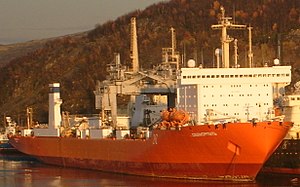Sevmorput

Sevmorput docked at Atomflot, Murmansk, in 2007.
|
|
| History | |
|---|---|
| Name: | Sevmorput (Севморпуть) |
| Namesake: | Severny Morskoy Put |
| Owner: | Russian Federation |
| Operator: |
|
| Port of registry: |
Murmansk, |
| Ordered: | 30 May 1978 |
| Builder: | Zaliv shipyard, Kerch, Ukraine |
| Cost: | US$265 million |
| Yard number: | 401 |
| Laid down: | 1 June 1982 |
| Launched: | 20 February 1986 |
| Completed: | 30 December 1988 |
| Commissioned: | 31 December 1988 |
| In service: | 1988–2007; 2016– |
| Identification: |
|
| Status: | In service |
| General characteristics | |
| Type: | LASH carrier/container ship |
| Tonnage: | |
| Displacement: | 61,880 tons (summer) |
| Length: | 260.30 m (854.0 ft) |
| Beam: | 32.20 m (105.6 ft) |
| Draught: |
|
| Depth: | 18.30 m (60.0 ft) |
| Ice class: |
|
| Installed power: | KLT-40 nuclear reactor (135 MW) |
| Propulsion: | |
| Speed: |
|
| Capacity: | |
Sevmorput (Russian: Севморпуть; IPA: [sʲɪvmɐrˈputʲ]) is a Russian nuclear-powered icebreaking LASH carrier and container ship. Named after the Northern Sea Route (Russian: Северный Морской Путь, Severny Morskoy Put), the 1988-built ship is one of only four nuclear-powered merchant ships ever built.
In October 2012, it was reported that Sevmorput would be decommissioned and sold for scrap, but this decision was reversed in December 2013.Sevmorput was laid up at the Atomflot base near Murmansk, Russia, until 2015 when she was returned to operational condition.
The history of Sevmorput dates back to a joint decision by the Ministry of the Merchant Marine (MORFLOT) and the Ministry of Shipbuilding Industry of the Soviet Union, No C-13/01360, which was signed on 30 May 1978. Following the development of heavy industry in the northern parts of the country, particularly around Norilsk, a reliable transportation method was needed to guarantee year-round shipments of cargo and supplies to and from the northern communities. Experiences from the nuclear icebreakers operating on the Northern Sea Route since the mid-1950s had shown the advantages of nuclear marine propulsion in the ice-infested waters of the Russian Arctic. Thus a decision was made to construct a new icebreaking LASH carrier, capable of serving high-volume shallow ports, that was powered by a nuclear reactor. The ship was designed by the Baltsudoproect Central Design Bureau.
...
Wikipedia
